17 Aug 2009
Mozart and Gluck — Mixed Results at Santa Fe
It is never easy to revive a success. Audiences will remember the first run of a show and consciously or not, compare a revival with earlier favorable impressions.

It is never easy to revive a success. Audiences will remember the first run of a show and consciously or not, compare a revival with earlier favorable impressions.
So it was with Santa Fe’s current Don Giovanni, which premiered in 2004 under the musical direction of Alan Gilbert with a stylish mise-en-scène and direction by the team of Zinn/Rader-Shieber, and a thoroughly first-rate cast.
This summer Don Giovanni is sharply different, and the problem starts with musical direction of Lawrence Renes, a young conductor from the Netherlands, who does not seem ready to conduct Mozart’s masterpiece. Success was also attenuated by a young lightweight cast, which had little chemistry as an ensemble, and few adequate voices. I am not one to linger over negatives, but some points need to be made. Renes was all motion and nervous energy on the podium, giving cues where none were needed, ignoring shape and elegance, elements that virtually define Don Giovanni. He spent much time shushing the orchestra, probably in favor of a small-voiced cast; too much energy was lost in the process. His tempo for the Champagne Aria was excellent, likewise the Act II Serenade; but like much of the rest of the score, he treated them as isolated events. Missing were both over-all sweep and sufficiently defined details of inner voices of the orchestra that create the aural excitement of this seminal Mozart. Bottom line: de-energized, boring music making, in spite of much fuss and feathers.
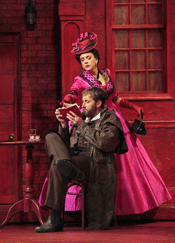 Susanna Phillips (Donna Elvira) & Matthew Rose (Leporello)
Susanna Phillips (Donna Elvira) & Matthew Rose (Leporello)
This translated over the footlights to the stage, where little style and at
times almost amateurish performances were evident. Lucas Meachem cast as a
swaggering Don, did not swagger — histrionically or vocally. He has a
pleasant, if mild musical comedy baritone that most of the time could not be
heard; he offered minimal physical style, and little ‘edge’ for a
man who likes to conquer women “just for the sake of the list,” (in
Santa Fe’s translation): one was much puzzled that he was cast by Santa
Fe. The same was true of the vocally lightweight, histrionically shallow
Leporello of Matthew Rose, a young singer not yet suited to the big leagues, at
least not on this occasion.
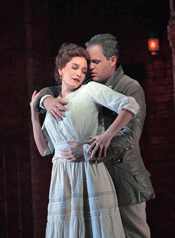 Kate Lindsey (Zerlina) and Corey McKern (Masetto)
Kate Lindsey (Zerlina) and Corey McKern (Masetto)
The pretty Zerlina of Kate Lindsey was too slight of voice and something of
a vamp, in a role that usually is more demure. In “Vedrai carino”
she began her aria of consolation far from the battered Masetto, and slithered
slowly, erotically across the wide stage, exposing and caressing her legs in
what amounted to a vulgar re-seduction of her battered groom. The aria was all
about her, not about comfort for him. This was likely not Lindsey’s doing
— the discredit belonging to director Chas. Rader-Shieber, who seemed
often inattentive to details in his revival production. It should be noted the
Masetto of Corey McKern was well-enough sung and played, one of the stronger
performances among lead singers.
Charles Workman was a competent Ottavio — his voice even-toned and pleasant, but as a player he was Clark Kent without benefit of telephone booth. His movements were stiff and clichéd, his two arias no more than well-routined.
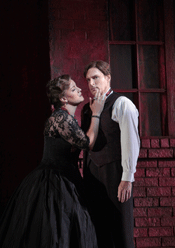 Elza van den Heever (Donna Anna) and Charles Workman (Don Ottavio)
Elza van den Heever (Donna Anna) and Charles Workman (Don Ottavio)
The news gets better with Donna Elvira and Donna Anna. Susanna Phillips is a
proven good thing as a Mozart singer and she again made her marks with the
opera’s most interesting character, the oft-betrayed Elvira.
Phillips’ generous warm soprano easily dispatched the coloratura demands
of the role, while her lyric singing was full-bodied and projected well.
Perhaps not the greatest actor, she nonetheless was in the spirit of her role
and commanded her music and all her scenes; most important, she could be heard!
Elza van den Heever, the South African-born, San Francisco-trained ‘baby
dramatic soprano’ (as she is called), turned in an intense, driven and
rather unsympathetic Donna Anna — often powerful, with a hard-edged
bright soprano that mined every note Mozart gave her. But the voice is
dynamically uneven, swinging from loud to soft, with awkward transitions. Her
tonal quality can be steely, and is rarely warm or especially attractive, yet
with further refinement she could be a useful singer in the right roles, as she
seems to possess good basic talent. At present van den Heever is house soprano
in a major German company, an experience that may be beneficial. She is worth
keeping an eye on.
Over-all the red-tinted production, which offers engaging play among many hues and tones of crimson — bright, outraged fuchsia for Elvira, black figurations with somber maroon for Anna — even red tinted trees, walls and windows, still surprises and offers favorable flow and good logistics. With improved musical direction, and a more mature cast, Santa Fe’s Don might recapture former glories.
Christophe Willibald Gluck’s 1776 French-language version of Alceste, the story of a self-sacrificing Thessalonian queen who would give her life for her husband’s, rises or falls on two factors: Dancing and strong dramatic soprano singing of the title role. Santa Fe had both.
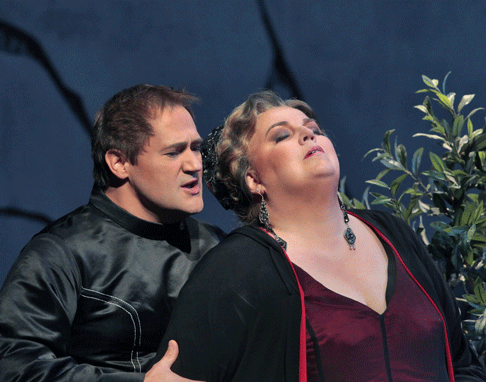 Paul Groves (Admète) & Christine Brewer (Alceste)
Paul Groves (Admète) & Christine Brewer (Alceste)
As the queen, Christine Brewer sang with powerful, often glowing tone, commanding a strong top register with unique richness in the mid and lower ranges — qualities that make an ideal voice for a part that is both feminine and heroic. As might be imagined, Alceste is not easy to portray on stage, and Gluck was not, frankly, much of a dramatist, though among the greatest of musicians and composers. Act I is largely lament for the dying king; Act II is lamentation for the dying queen, and Act III is about both, then with a happy quick ending due to the beneficent intervention of legendary strongman Hercules and the god Apollo. The story is a compound of ancient Greek myth and legends, later made into a tragedy by Euripides, then further compounded into a drama for 18th-Century audiences by Gluck’s librettist Calzabigi. It is the work of many hands and seems it. Fortunately the glorious music unifies all into a musical whole, if not dramatic success — it is simply too repetitious.
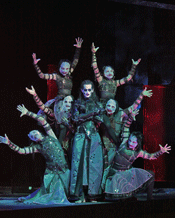 Tom Corbeil (The Infernal God)
Tom Corbeil (The Infernal God)
Since Alceste is a stand-about opera, what do you do but dance! Santa Fe
brought in a wizardly choreographer and solo dancer from Spain, one Ana Yepes,
a tiny woman who twirls and whirls onto the stage with a troupe of seven
dancers, and also some choreographed chorus members and even a dancing tenor or
two, and stirs up a delightful mélange of movement, motion and gesture,
representing — well, whatever you want: the divinities of Hell, the local
folk observing the antics of royalty and gods, the moods of the characters and
their music, even at one point a little swaying audience of dancing figures for
the second verse of Alceste’s mighty defiance aria, “Divinités du
Styx,” sung with thrilling power and musical accent by Mme. Brewer. Many
a singer would not have allowed that distraction during her principal aria.
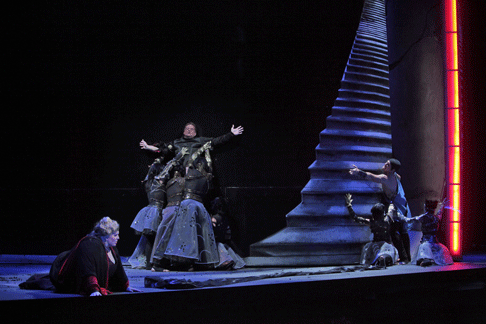 Christine Brewer (Alceste), Paul Groves (Admète) & Wayne Tigges (Hercule)
Christine Brewer (Alceste), Paul Groves (Admète) & Wayne Tigges (Hercule)
What did it all look like? It is not easy to say — the Queen and her King Admète (handsome, musically stylish tenor Paul Groves), were in either stately robes or classic Greek attire; the chorus in non-descript low colored robes, save for the ones that danced who had a touch of color, and the dancers themselves in what I would call ‘comic-book gothic,’ close fitting garb, though another observer offered terms such as ‘Buck Rogers’ or ‘outer-space.’ Apollo was in gold, a bully Hercule showed a lot of skin, and stately Mme. Brewer, fortunately, kept her dignity while grieving mightily for her ailing husband in Act I, and herself in Act II. Happily in the final scene she showed us a beautiful radiant smile.
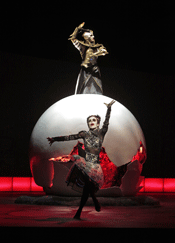 Matthew Morris (Apollo) & Ana Yepes (Dancer)
Matthew Morris (Apollo) & Ana Yepes (Dancer)
The imaginative stage director Francisco Negrin had the audience looking
into what could have been the open end of a stage-sized cornucopia, or perhaps
a horn of plenty, which curved into to a vanishing point and was sometimes
blue, sometimes white — impressionistic and useful as generalized
background, with a large ovoid shape, cracked open in the middle and glowing
red therefrom, that appeared now and then. An oracular site? The gate to Hell?
Google is no help! What really counted was the emotional effect of the music
and singing, and here the proponents were strong and convincing. One will not
soon forget the beauty and expressivity of the dramatic soprano’s tones
in her various arias; nor of the well-modulated chorus; or the
orchestra’s elegant playing, so balanced and refined under conductor
Kenneth Montgomery, Santa Fe’s long-time and admirable resident
classicist. A beautiful, if basically boring opera, well achieved.
J. A. Van Sant © 2009